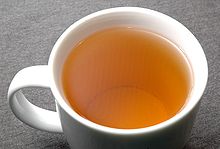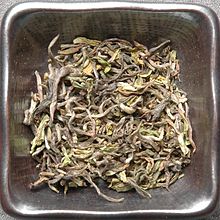- Darjeeling tea
-
For other uses, see Darjeeling tea (disambiguation).
Darjeeling Type: Usually sold as Black Other names: The Champagne of Teas[citation needed] Origin: Darjeeling, India Quick description: Fruity, floral, astringent. Darjeeling tea is a black tea from the Darjeeling region in West Bengal, India. When properly brewed, it yields a thin-bodied, light-colored infusion with a floral aroma. The flavor also displays a tinge of astringent tannic characteristics, and a musky spiciness often referred to by tea connoisseurs[who?] as "muscatel." Although Darjeeling black teas are marketed commercially as "black tea", almost all of them have incomplete oxidation (<90%), so they are technically more Oolong than black.
Unlike most Indian tea, Darjeeling is normally made from the small-leaved Chinese variety of Camellia sinensis var. sinensis, rather than the large-leaved Assam plant (C. sinensis var. assamica). Traditionally, Darjeeling tea is made as black tea; however, Darjeeling oolong and green teas are becoming more commonly produced and easier to find, and a growing number of estates are also producing white teas[citation needed]. After the enactment of Geographical Indications of Goods (Registration & Protection Act, 1999) in 2003, Darjeeling tea became the first Indian product to receive a GI tag, in 2004-05 through the Indian Patent Office.[1]
Contents
History
Further information: History of tea in IndiaTea planting in the Indian district of Darjeeling had begun during 1841 by Dr. Campbell[citation needed], a civil surgeon of the Indian Medical Service. Campbell was transferred to Darjeeling in 1839 and used seeds from China to begin experimental tea planting, a practice that he and others continued during the 1840s. The government also established tea nurseries during that period. Commercial development began during the 1850s.[citation needed]
Designation
 Logo of the Darjeeling Tea Association. The central portion is the actual certification mark.
Logo of the Darjeeling Tea Association. The central portion is the actual certification mark.
According to the Tea Board of India - "Darjeeling Tea" means: tea which has been cultivated, grown, produced, manufactured and processed in tea gardens (see 'Estates' section below) in the hilly areas of Sadar Sub-Division, only hilly areas of Kalimpong Sub-Division consisting of Samabeong Tea Estate, Ambiok Tea Estate, Mission Hill Tea Estate and Kumai Tea Estate and Kurseong Sub-Division excluding the areas in jurisdiction list 20,21,23,24,29,31 and 33 comprising Siliguri subdivision of New Chumta Tea Estate, Simulbari and Marionbari Tea Estate of Kurseong Police Station in Kurseong Sub-Division of the District of Darjeeling in the State of West Bengal, India grown on picturesque steep slopes up to 4000 ft. Tea which has been processed and manufactured in a factory located in the aforesaid area, which, when brewed, has a distinctive, naturally occurring aroma and taste with light tea liquor and the infused leaf of which has a distinctive fragrance.
Adulteration and falsification are serious problems in the global tea trade;[citation needed] the amount of tea sold as Darjeeling worldwide every year exceeds 40,000 tonnes,[citation needed] while the annual tea production of Darjeeling itself is estimated at only 10,000 tonnes, including local consumption.[citation needed] To combat this situation, the Tea Board of India administers the Darjeeling certification mark and logo (see right).[2] Protection of this tea designation is similar in scope to the protected designation of origin used by the EU for many European cheeses.
Darjeeling tea cannot be grown or manufactured anywhere else in the world, similar to Champagne in that region of France.[citation needed]
Varieties
 After steeping
After steeping
Traditionally, Darjeeling teas are classified as a type of black tea. However, the modern Darjeeling style employs a hard wither (35-40% remaining leaf weight after withering), which in turn causes an incomplete oxidation for many of the best teas of this designation, which technically makes them a form of oolong. Many Darjeeling teas also appear to be a blend of teas oxidized to levels of green, oolong, and black.
- 1st Flush is harvested in mid-March following spring rains, and has a gentle, very light color, aroma, and mild astringency.
- In Between is harvested between the two "flush" periods.
- 2nd Flush is harvested in June and produces an amber, full bodied, muscatel-flavored cup.
- Monsoon or Rains tea is harvested in the monsoon (or rainy season) between 2nd Flush and Autumnal, is less withered, consequently more oxidized, and usually sold at lower prices. It is rarely exported, and often used in Masala chai.
- Autumnal Flush is harvested in the autumn after the rainy season, and has somewhat less delicate flavour and less spicy tones, but fuller body and darker colour.
Grades
When Darjeeling teas are sold, they are graded by size and quality. The grades fall into four basic groups: whole leaf, broken leaf, fannings, and dust.
Whole Leaf
- SFTGFOP: Super Fine Tippy Golden Flowery Orange Pekoe indicates that it contains many tips and are long and wiry in appearance. The liquors are lighter in color.
- FTGFOP: Fine Tippy Golden Flowery Orange Pekoe.
- TGFOP: Tippy Golden Flowery Orange Pekoe
Broken Leaf consists of small tea leaves or pieces of large leaves.
- FTGBOP: Fine Tippy Golden Broken Orange Pekoe.
- TGBOP: Tippy Golden Broken Orange Pekoe.
- FBOP: Flowery Broken Orange Pekoe.
- BOP: Broken Orange Pekoe.
Fannings consists of even smaller leaf size than the brokens.
- GFOF: Golden Flowery Orange Fannings.
- GOF: Golden Orange Fannings.
Dust represents the lowest grade in classification, consists of small pieces of tea leaves and tea dust.
- D: Dust.
Estates
 Tea Garden on the way to Rock Garden, Darjeeling
Tea Garden on the way to Rock Garden, Darjeeling
There are many tea estates (also called "tea gardens") in Darjeeling, each producing teas with different character in taste and aroma. Some of the popular estates include Arya, Chamong, Glenburn, Lingia, Castleton, Jungpana, Makaibari, Margaret's Hope, and Risheehat. Below is a non-exhaustive list:
- Ambootia
- Arya
- Avongrove
- Badamtam
- Balasun
- Bannockburn
- Barnesbeg
- Castleton
- Chamong
- Chongtong
- D'alrus
- Gielle
- Giddapahar
- Ging
- Glenburn
- Goomtee
- Gopaldhara
- Happy Valley
- Hilton
- Jogmaya
- Jungpana
- Kaley Valley
- Kanchan View
- Lingia
- Longview
- Makaibari
- Margaret's Hope
- Mim
- Moondakotee
- Mission Hill
- Nagri
- Namring
- Orange Valley
- Puttabong
- Peshoke
- Phoobsering
- Phuguri
- Poobong
- Potong
- Princeton
- Pussimbing
- Ringtong
- Risheehat
- Rohini
- Runglee Rungliot
- Samabeong
- Seeyok
- Selimbong
- Singbulli
- Singell
- Singla
- Soom
- Soureni
- Snowview
- Steinthal
- Sungma
- Takdah
- Teesta Valley
- Thurbo
- Tindharia
- Tongsong Dtriah
- Tumsong
- Upper Fagu
- Vah Tukvar
See also
- Teekampagne - World’s largest importer of Darjeeling loose tea
References
- ^ "GI tag: TN trails Karnataka with 18 products". The Times of India. Aug 29, 2010. http://timesofindia.indiatimes.com/city/chennai/GI-tag-TN-trails-Karnataka-with-18-products/articleshow/6458268.cms.
- ^ Gadi Kenny, Trade & Environment Database (TED) Journal, Number 752, July 2004, American University. ([1] accessed on 2007-03-14)
External links
Tea Black tea Oolong tea - Bai Ji Guan
- Red Robe
- Darjeeling Oolong
- Dongding (Tung-ting)
- Dong Fang Mei Ren
- Huangjin Gui (Golden Osmanthus)
- Qilan tea
- Pouchong
- Rou Gui
- Shui Jin Gui
- Shui Hsien (Shui Xian)
- Tie Luohan
- Tieguanyin (Iron Goddess)
Green tea - Aracha
- Bancha
- Green Spiral
- Chun Mee
- Da Fang
- Genmaicha
- Liuan Leaf
- Gunpowder
- Gyokuro
- Hojicha
- Hou Kui
- Huang Shan Mao Feng
- Hyson
- Kabusecha
- Kamairicha
- Konacha
- Kukicha
- Longjing (Dragon Well)
- Matcha
- Mao Jian
- Mecha
- Meng Ding Gan Lu
- Sencha
- Shincha
- Tamaryokucha
White tea Yellow tea Post-fermented tea Blended and
flavoured teasTea culture Tea beverages Other - Camellia sinensis (tea plant)
- Tea bag
- Teapot
- Consumption
- Flowering tea
- Glass-holder
- Health effects
- Tea processing
- Samovar
- Tea brick
- Tea garden
- Tea house
- Tea tasting
- Teakettle
See also Categories:- Indian tea
- Black tea
Wikimedia Foundation. 2010.





